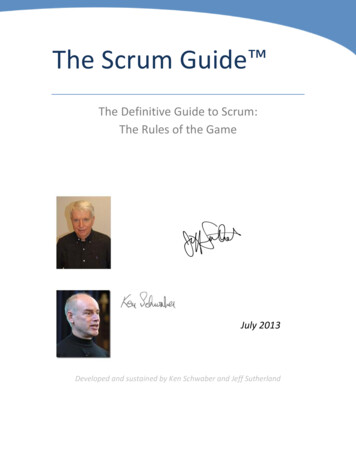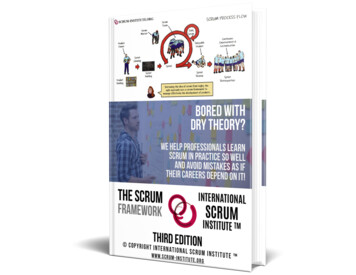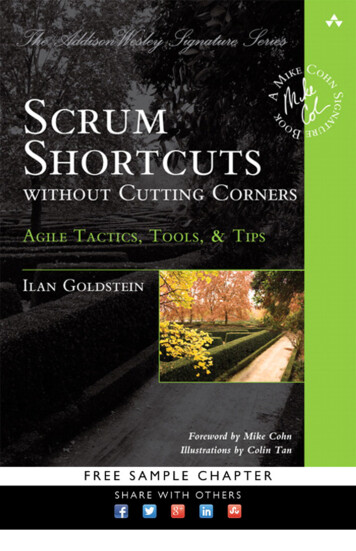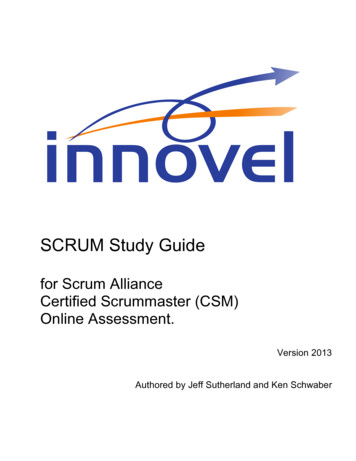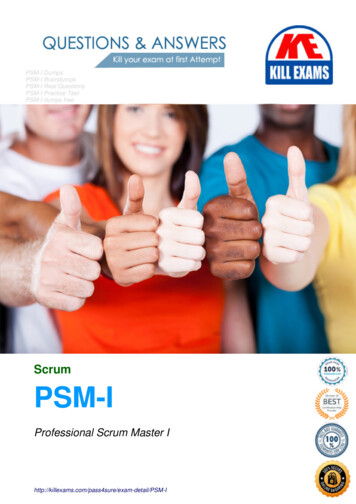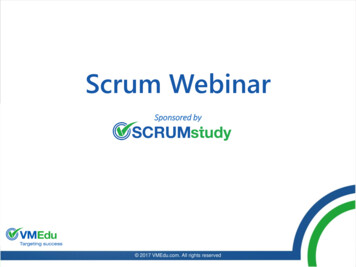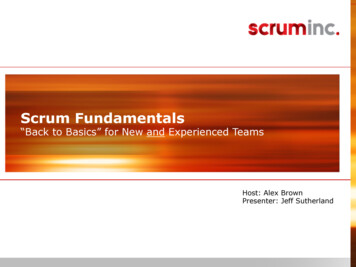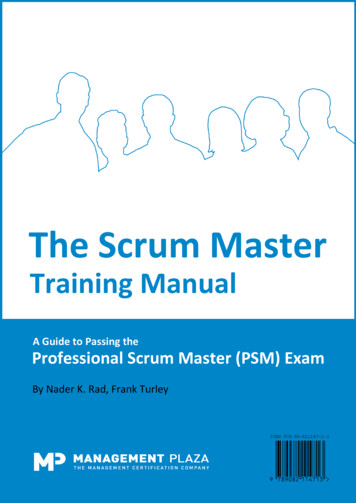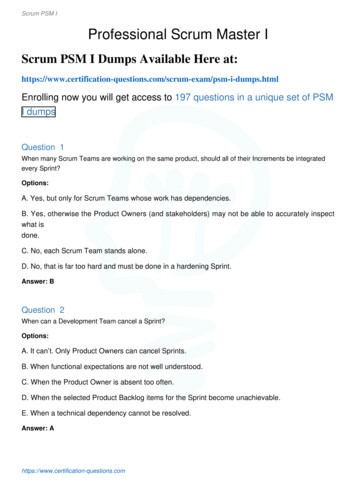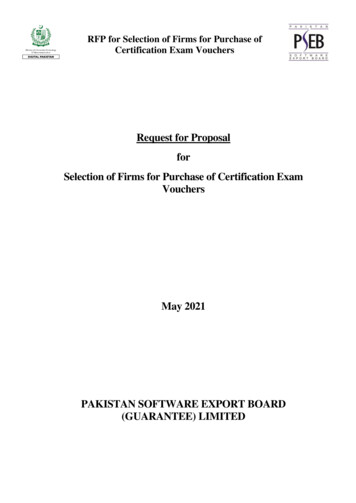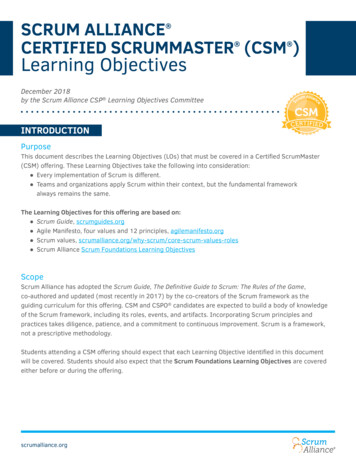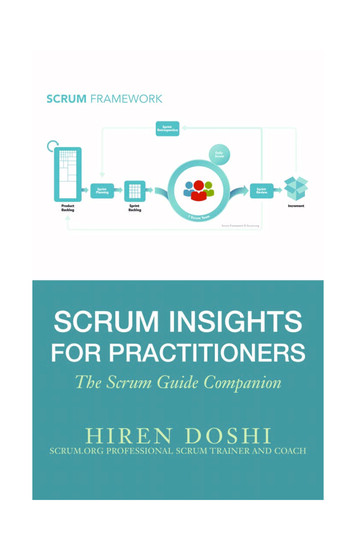
Transcription
Scrum Insightsfor Practitioners
Scrum Insightsfor PractitionersTHE SCRUM GUIDE COMPANION Hiren Doshi
2016 Hiren DoshiAll rights reserved.ISBN: 0692807179ISBN 13: 9780692807170
ContentsForeword by Gunther Verheyen . . . . . . . . . . . . . . . . . . . . . . . . . xiRecommendations . . . . . . . . . . . . . . . . . . . . . . . . . . . . . . . . . . . xiiiAcknowledgments . . . . . . . . . . . . . . . . . . . . . . . . . . . . . . . . . . . . xvPreface . . . . . . . . . . . . . . . . . . . . . . . . . . . . . . . . . . . . . . . . . . . .xviiScrum Theory and Definition of Scrum. . . . . . . . . . . . . . . . . . . . 1What Is Scrum? . . . . . . . . . . . . . . . . . . . . . . . . . . . . . . . . . . . . 1What Is a Complex Adaptive Problem? . . . . . . . . . . . . . . . . . 2What Is Empirical Process Control, or Empiricism? . . . . . . . 5The Three Pillars of Empiricism (Scrum) . . . . . . . . . . . . . . . 6The Scrum Values . . . . . . . . . . . . . . . . . . . . . . . . . . . . . . . . . . . . . 8Courage . . . . . . . . . . . . . . . . . . . . . . . . . . . . . . . . . . . . . . . . . . 9Focus. . . . . . . . . . . . . . . . . . . . . . . . . . . . . . . . . . . . . . . . . . . . 10Commitment . . . . . . . . . . . . . . . . . . . . . . . . . . . . . . . . . . . . . 10Respect . . . . . . . . . . . . . . . . . . . . . . . . . . . . . . . . . . . . . . . . . . 10Openness . . . . . . . . . . . . . . . . . . . . . . . . . . . . . . . . . . . . . . . . 11The Scrum Team . . . . . . . . . . . . . . . . . . . . . . . . . . . . . . . . . . . . . 12The Product Owner. . . . . . . . . . . . . . . . . . . . . . . . . . . . . . . . 12The Scrum Master . . . . . . . . . . . . . . . . . . . . . . . . . . . . . . . . . 16The Development Team . . . . . . . . . . . . . . . . . . . . . . . . . . . . 18Development Team Size . . . . . . . . . . . . . . . . . . . . . . . . . . . . 20The Availability of the Three Roles . . . . . . . . . . . . . . . . . . . 21
Scrum Events . . . . . . . . . . . . . . . . . . . . . . . . . . . . . . . . . . . . . . . . 24Sprint . . . . . . . . . . . . . . . . . . . . . . . . . . . . . . . . . . . . . . . . . . . 24Sprint Planning . . . . . . . . . . . . . . . . . . . . . . . . . . . . . . . . . . . 27Daily Scrum . . . . . . . . . . . . . . . . . . . . . . . . . . . . . . . . . . . . . . 31Sprint Review . . . . . . . . . . . . . . . . . . . . . . . . . . . . . . . . . . . . . 36Sprint Retrospective . . . . . . . . . . . . . . . . . . . . . . . . . . . . . . . 39Product Backlog Refinement . . . . . . . . . . . . . . . . . . . . . . . . . 42Scrum Artifacts . . . . . . . . . . . . . . . . . . . . . . . . . . . . . . . . . . . . . .46Product Backlog . . . . . . . . . . . . . . . . . . . . . . . . . . . . . . . . . . .46Sprint Backlog . . . . . . . . . . . . . . . . . . . . . . . . . . . . . . . . . . . . 47Product Increment . . . . . . . . . . . . . . . . . . . . . . . . . . . . . . . . .49Artifact Transparency . . . . . . . . . . . . . . . . . . . . . . . . . . . . . . . . . 50Definition of “Done” . . . . . . . . . . . . . . . . . . . . . . . . . . . . . . . 50Self-Organization . . . . . . . . . . . . . . . . . . . . . . . . . . . . . . . . . . . . . 56What Is Self-Organization?. . . . . . . . . . . . . . . . . . . . . . . . . . 56How Does Scrum Promote Self-Organization? . . . . . . . . . . 56What Are Some Signs That Teams Are Self-Organizing? . . . 58How Does Time-Boxing Promote Self-Organization? . . . . 58How Do the Scrum Roles Promote Self-Organization? . . . 58Myths, Mysteries, and Misconceptions of Scrum . . . . . . . . . . . . 61What Are Sprint 0, Hardening Sprints, ReleaseSprints, and Stabilization Sprints?. . . . . . . . . . . . . . . . . . . . . 61Is Scrum a Methodology or a Framework? . . . . . . . . . . . . . . 61My Designation Is Development Manager. DoesThis Mean I Have No Role In Scrum? . . . . . . . . . . . . . . . . . 62How Is Architecture Handled in Agile? . . . . . . . . . . . . . . . . 63One Scrum Team Is Currently Developing a Product.What Impact Will It Have on Its Productivity WhenOne More Scrum Team Is Deployed in This ProductDevelopment Effort? . . . . . . . . . . . . . . . . . . . . . . . . . . . . . . . 65
What Are Commonly Observed Scrum Myths,Mysteries, and Misconceptions? . . . . . . . . . . . . . . . . . . . . . .66A Case Study on Scrum-Based Product Development . . . . . . . . 69An example of a PBI in “Ready” state . . . . . . . . . . . . . . . . . . 71Author’s Thoughts and Conclusion . . . . . . . . . . . . . . . . . . . . . . . 77Appendix . . . . . . . . . . . . . . . . . . . . . . . . . . . . . . . . . . . . . . . . . . . . 79Best Practice: Scrum Board, as a Visualization ofSprint Backlog . . . . . . . . . . . . . . . . . . . . . . . . . . . . . . . . . . . . 79Emergent Architecture: An Example . . . . . . . . . . . . . . . . . .80References . . . . . . . . . . . . . . . . . . . . . . . . . . . . . . . . . . . . . . . . . . . 83Author Biography . . . . . . . . . . . . . . . . . . . . . . . . . . . . . . . . . . . . . 85
To mywonderful parents;beautiful wife, Swati; andloving daughters, Aditi and Ashwini.
Foreword by GuntherVerheyen Scrum grew less and less complete and “perfect” over time.Practices and techniques were gradually removed from the official definition of Scrum in The Scrum Guide. As the global Scrumadoption grew and Scrum became the most adopted method forAgile software development, more and more space was created forvariation in techniques and practices by eliminating specific instructions from the official body of knowledge of Scrum. Scrumturned into the framework that it was always designed to be, aframework that enables practitioners to devise their own solutions.In his book Scrum Insights for Practitioners, Hiren has extended the core rules of The Scrum Guide with practices he has founduseful. Hiren answers questions regarding Scrum that potentiallyremain unanswered even after one reads The Scrum Guide. Hirendismantles common misconceptions about Scrum, regardless ofthe source of such misconceptions. Hiren elaborates on basic information provided in The Scrum Guide, as well as on the principles underlying Scrum.xi
Hiren DoshiHiren shows that experts understand that there are still manypeople new to Scrum looking for help and guidance, people whomight not have the possibility to learn through extensive experience. Hiren respects people looking for information additional toThe Scrum Guide, without ever turning any of his advice, practices,or insights into “must” prescriptions.Reading The Scrum Guide and additionally reading ScrumInsights for Practitioners provides any aspiring Scrum practitionerwith valuable base insights, without leaving the impression it canreplace actual experience.Enjoy reading. Keep Scrumming.Gunther VerheyenIndependent Scrum CaretakerAntwerpSeptember 22, 2016xii
Recommendations “One of the best things about Scrum is its simplicity. It’svery easy to get started using Scrum, but if you’re notcareful, you can make a lot of mistakes. Take advantageof Hiren’s vast experience and avoid making the commonerrors people make as they begin their journey. This bookcontains a wealth of practical information that will be useful to readers as they work to implement the basic theoryfound in The Scrum Guide.”—Steve Porter, team member,Scrum.org“Hiren Doshi has written a fine companion to The ScrumGuide, filling in some of the intentional gaps left in theScrum framework. Using this companion along withThe Scrum Guide will undoubtedly improve the outlookfor those teams that internalize its teachings.”—CharlesBradley, ScrumCrazy.com“This book will help you understand the nuances ofScrum. It takes a very practical approach toward implementing Scrum without compromising on its values andprinciples. Perhaps the first book on Scrum that newbiesxiii
Hiren Doshishould read after going through The Scrum Guide. A usefuland handy reference for Scrum practitioners!”—GopinathR., Agile coach and practitionerxiv
Acknowledgments I’m incredibly honored and privileged to have the best Scrumexperts in the industry as the official reviewers of my first book.I owe a tremendous debt to Steve Porter, Gunther Verheyen, andCharles Bradley for reading and providing their expert commentson the manuscript. Each of them has provided valuable insights tomake my writing more complete. Thank you.Very special thanks to Gopinath Ramakrishnan, a good friendand a Scrum expert himself, for reviewing and editing the manuscript during my early days of writing and providing me with valuable insights. Thank you for being patient with me and helping meimprove the manuscript.Thank you, Gunther Verheyen, for writing such a fantasticforeword. I am honored.Thank you, Ken Schwaber and Jeff Sutherland, for teachingme Scrum.xv
Hiren DoshiFinally, a thank-you to my wife, Swati, for reviewing the bookand giving her valuable insights. I also thank her for always beingthere for me throughout the journey. Thank you!xvi
Preface Scrum is a framework to manage complex product development.The framework consists of three roles, five formal events, threeartifacts, and the rules that bind these elements together. TheScrum Guide is the one and only official description of Scrum andis freely available at ScrumGuides.org. The Scrum Guide is writtenand maintained by the cocreators of Scrum, Ken Schwaber andJeff Sutherland.The Scrum Guide holds the bare and essential rules of Scrum.It provides sufficient information to understand Scrum but leavesmuch open for interpretation by readers and practitioners. Whenindividuals and organizations follow The Scrum Guide blindly,without understanding the real, deep essence of Scrum—the principles and values underpinning the framework—they likely willfail to reap all the benefits Scrum has to offer.As noted in The Scrum Guide, Scrum can be compared to thegame of chess: easy to understand but difficult to master. Why?As in the game of chess, the rules of the game are very simple,but the game has millions of strategies by which it can be played.How many grand masters do we know who have mastered chess?xvii
Hiren DoshiMost likely we will be able to count the names on the fingers ofour hands.Ten years back, I started my Agile software developmentjourney via Scrum. I began my practice for a large organizationin the United States by just reading The Scrum Guide. I enjoyedevery moment of the journey, and I was under the impression thatI was doing a fabulous job with the Scrum adoption in the organization. Luckily, six months into the adoption, I started attending Ken Schwaber’s Scrum-But sessions, held in his Burlington,Massachusetts, office. These sessions were eye-openers for meas I realized that I did not really have a deep understanding ofwhat Scrum is and the way it is supposed to be practiced. In fact,it was much worse than that: I had not just limited my muddied understanding of Scrum to myself, but I had distributed thisknowledge to many others who collaborated with me on productdevelopment.Scrum Insights for Practitioners fills in some gaps in the understanding of Scrum for individuals or organizations practicingScrum. This book can be thought of as a companion to The ScrumGuide. I encourage readers to first read The Scrum Guide if you arenew to Scrum before reading this book, as this will help you reapthe maximum benefits.Scrum Insights for Practitioners is a perfect companion to TheScrum Guide that helps the practitioners master the Scrum framework by gaining in-depth practical insights and helps answer questions such as these:xviii
Scrum Insights for Practitioners!!!!!!!!!!What are some common myths, mysteries, and misconceptions of Scrum?The Scrum Guide recommends three to nine members in aDevelopment Team, but we have fifteen members. Is thisScrum?Can you share some tactics to do effective Sprint Planning,Daily Scrum, Sprint Review, Sprint Retrospective, andProduct Backlog Refinement?My designation is development manager. Does this mean Ihave no role in Scrum?How is Scrum Empirical?Can Scrum Master and Product Owner be the sameperson?We don’t have a Scrum Master. Are we still practicingScrum?What does self-organization really mean?How does Scrum embrace the four values and twelve principles of the Agile Manifesto?Please share a case study on Scrum-based productdevelopment?This book is a collection of my experiences and learning and willprovide you guidance and suggestions about adopting Scrum. Itwill also help clear up the myths and misconceptions of Scrum.Each organization’s business context varies, and it is very difficultto prescribe a best practice that will work for everyone. You are ina better position to understand the exact circumstances of yourbusiness needs and adapt accordingly.xix
Scrum Theory andDefinition of Scrum What Is Scrum?As defined in THE SCRUM Guide, Scrum is a lightweight frameworkfounded on empirical process control theory that supports smallteams in addressing complex adaptive problems while productivelyand creatively delivering products of the highest possible value.1
Hiren DoshiAN ALTERNATIVE DEFINITION OF SCRUMScrum is an iterative way of developing software in a Sprint (atime-box of one month or less), incrementally delivering working software every Sprint, incorporating customer feedback onthe working software, and ensuring that the right business valueis delivered in each Sprint.What Is a Complex Adaptive Problem?According to the Cynefin framework, by David Snowden, any software project that you pick up can be bucketed in one of four categories:Cynefin FrameworkBy Snowded, 2014, Last modified July 6 2014. https://commons.wikimedia.org/w/index.php?curid 33783436.2
Scrum Insights for Practitioners!!!!Obvious: Everything about the project is known.Complicated: More about the project is known than isunknown.Complex: More about the project is unknown than isknown.Chaotic: Everything is unknown. There is no provenapproach.Each category requires a different approach:Projects in the Obvious and Complicated domains can followa predictive model—plan driven or waterfall—and a project plancan be put in place as most of the requirements, the technology,and people aspects of the projects are well known in advance andhold few uncertainties.Example 1: Rewriting an existing payroll application.Example 2: Building a sea link using a suspended bridge toconnect two cities. Although this might not sound like a simple,uncomplicated project, it actually is. Humans have been buildingbridges for centuries, and we have accumulated plenty of data onthe same. The data can be analyzed to put a solid plan together,and most likely one can comfortably predict the time and costneeded to build a bridge with no more than 5 to 10 percent variance on the planned work.If we are very certain about the project requirements and thetechnology we plan to use, it is well proven that a predictive modelis a better choice.3
Hiren DoshiFor Chaotic projects no defined process works, as almosteverything about the project is unknown and is subject to extensive changes. The best model for such projects is to act inorder to establish some type of direction and then decide on thenext move.Software projects reside in the Complex domain, as it is extremely difficult to envision the exact final outcome of the productand how the market will embrace it when it is released. Productsand services like Uber, Apple, Google, Amazon, and Facebookhave evolved over time. The founders of these companies mostlikely did not envision the exact products that we use today whenthey conceived the first ideas. The complexity in software arises from these facts: there are many unknown variables, and forknown variables the variance is too much.These are some of the variables that make software development complex:1. Requirements: Software requirements never stop changing. The customer often will not know what he or shewants until the customer can actually use the product.2. Technology: This is an ever-changing variable.3. People: The people aspect is very unpredictable (e.g., attrition, leaves of absence, skill gaps).For complex projects, empirical process control, or empiricism, isthe best-suited approach.4
Scrum Insights for PractitionersWhat Is Empirical Process Control, orEmpiricism?Empiricism means working in a fact-based, experience-based, andevidence-based manner. Scrum implements an empirical processwhere progress is based on observations of reality, not fictitiousplans.Here is an analogy to explain empiricism:Assume you need to develop twenty-five equally sized featuresfor a product before it can be released to the market. You agree todevelop five features in each one-month Sprint. This means youwill complete twenty-five features in five Sprints—that is, five features delivered by the end of each one-month Sprint.Suppose you complete seven features in the first Sprint insteadof the planned five. This evidence of your real progress gives youthe insight that you can take on more features in the next Sprint—that is, seven features instead of the planned five. This also meansthat the project might turn out to be much simpler than you anticipated, and instead of five Sprints to complete all twenty-fivefeatures, you might end up needing only four Sprints.Suppose, however, that you complete only two features instead of the planned five in the first Sprint. This evidence of actualprogress gives you the insight that you had better take on fewerfeatures in the next Sprint—that is, two features instead of theplanned five. This also means that the project might turn out to bemore difficult than you anticipated. Instead of five Sprints to complete all twenty-five features, you might need over twelve Sprints.5
Hiren DoshiIf you are not able to complete any features in a Sprint, thenyou still come away with the insight that you might need to sliceand plan your work in a very different way.Thus, real data enable good decision making in a timelymanner. Contrast this with a traditional predictive model—likewaterfall—where sponsors spend huge amounts of money without knowing the outcome for a very long period, often years.Scrum, due to its empirical nature, is very appealing to sponsors as at the end of each Sprint, a potentially releasable “Done”Product Increment is available. The increment can be inspectedand potentially released if deemed sufficiently valuable every onemonth or less.The Three Pillars of Empiricism (Scrum)Scrum is empirical and places great emphasis on mind-set andcultural shift to achieve business and organizational Agility. Thethree pillars of empirical process control are as follows:!!Transparency: This means presenting the facts as is.All people involved—the customer, the CEO, individualcontributors—are transparent in their day-to-day dealingswith others. They all trust each other, and they have thecourage to keep each other abreast of good news as wellas bad news. Everyone strives and collectively collaboratesfor the common organizational objective, and no one hasany hidden agenda.Inspection: Inspection in this context is not an inspectionby an inspector or an auditor but an inspection by everyone on the Scrum Team. The inspection can be done for6
Scrum Insights for Practitioners!the product, processes, people aspects, practices, and continuous improvements. For example, the team openly andtransparently shows the product at the end of each Sprintto the customer in order to gather valuable feedback. If thecustomer changes the requirements during inspection, theteam does not complain but rather adapts by using this asan opportunity to collaborate with the customer to clarifythe requirements and test out the new hypothesis.Adaptation: Adaptation in this context is about continuousimprovement, the ability to adapt based on the results ofthe inspection. Everyone in the organization must ask thisquestion regularly: Are we better off than yesterday? Forprofit-based organizations, the value is represented in termsof profit. The adaptation should eventually relay back to oneof the reasons for adapting Agile—for example, faster timeto market, increased return on investment through valuebased delivery, reduced total cost of ownership throughenhanced software quality, and improved customer and employee satisfaction.Scrum works not because it has three roles, five events, and threeartifacts but because it adheres to the underlying Agile principlesof iterative, value-based incremental delivery by frequently gathering customer feedback and embracing change. This results infaster time to market, better delivery predictability, increased customer responsiveness, ability to change direction by managingchanging priorities, enhanced software quality, and improved riskmanagement.7
The Scrum Values The Scrum pillars of transparency, inspection, and adaptationcome to life and build trust for everyone when the Scrum valuesare embodied and lived by everyone. The Scrum values are courage, focus, commitment, respect, and openness.Successful use of Scrum depends on people becoming moreproficient in adapting their behavior to these five Scrum values.Gunther Verheyen has captured the values very well on his blog:Gunther, V. (May 2015). e-in-the-scrum-values/8
Scrum Insights for PractitionersScrum ValuesThis is my interpretation and adaptation of his text:CourageThe Scrum Team members have the courage to do the right thingand collaborate on difficult problems. They show courage in beingtransparent and sharing risks and benefits as they are. They admitthat requirements will never be close to perfect and show couragenot only by acknowledging that but also by adapting to changing requirements and direction. They show courage in admittingthat nobody is perfect and accepting people for who they are. TheScrum Team shows the courage to promote Scrum and empiricism to deal with complexity.9
Hiren DoshiFocusEveryone focuses on the work of the Sprint and the goals of theScrum Team. The time-boxes of Scrum allow a Scrum Team tofocus on delivering valuable working software at a sustainable pace.The team focuses on simplicity (e.g., no gold plating) and delivering to the needs of the customer. The team focuses on embeddinggood engineering practices for Lean software development andincreased value and quality delivery.CommitmentPeople personally commit to achieving the goals of the ScrumTeam. They commit to the Agile values and principles as documented in the Agile Manifesto. The Scrum Team commitsto building working software, to quality, to collaborating, tolearning, to self-organizing, to building the right thing for itscustomers, to excelling, to being creative and innovating, to continuously improving upon regular inspections and adaptations,to the Scrum framework, to transparency, and to challengingthe status quo.RespectScrum Team members respect each other to be capable and independent people. They show respect for people. They respect diversity. They respect the Scrum roles, rules, and principles. Theyshow respect by building valuable, releasable-quality workingsoftware with every Sprint.10
Scrum Insights for PractitionersOpennessThe Scrum Team and its stakeholders agree to be open about allthe work and the challenges with performing the work. They areopen to collaborating within the team and with the organization.They are open to being transparent.11
The Scrum Team A Scrum Team has three roles:!!!The Product OwnerThe Scrum MasterThe Development TeamThe various levels of service and their responsibilities in the ScrumTeam are as follows:!!!The Scrum Master serves the Development Team and theProduct Owner.The Development Team serves the Product Owner.The Product Owner serves the stakeholders.The Product Owner!The Product Owner in Scrum is an entrepreneur—a valuemaximizer and optimizer. The Product Owner ensuresthat the Development Team works on the most valuable12
Scrum Insights for Practitioners!!!!!functionality first. The primary tool for a Product Ownerto do so is the ordered Product Backlog.The Product Owner is a product manager. To maximizethe value of the product, the Product Owner needs awareness of competitive research, product vision, forecastingand feasibility, road mapping, return on investment, totalcost of ownership, and so forth.The Product Owner sets a solid vision to help the ScrumTeam keep a laser-sharp focus and direction that helpswith incremental progress.One product has only one Product Backlog and only oneProduct Owner. Having one Product Owner for the product maximizes clarity and focus, ensures quick decisionmaking, and eliminates wasteful delays by making a singleperson accountable for the success of the product.To validate the idea, the Product Owner frequently releases the software increment to market to gain real customerinsights.The Product Owner is accountable for and has the finalsay on the ordering of the Product Backlog. The ProductOwner orders the Product Backlog items (PBI) in theProduct Backlog by balancing many parameters, such asthe value of a PBI, the dependencies between PBIs, anddependencies on other products.! Value realized can be determined by the following:! Revenue for profit-based organizations (e.g.,Amazon, Apple, Google)! Benefits to society by not-for-profit organizations(e.g., American Red Cross, UNICEF, BRAC,CARE)13
Hiren DoshiValue in itself is hard to quantify, but KPIs can be used tomeasure how effective we are in delivering value. Somemetrics to measure value are defined in the frameworkof evidence-based management for software organizations available through http://www.ebmgt.org:! Feature Usage Index: How much functionality ofthe product is being utilized?! Installed Version Index: What percentage of yourcustomers is on your latest release?! Innovation Rate: What percentage of your product budget is spent on building new functionalityversus maintaining existing functionality versusexpanding capabilities?! On-Product Index: What percentage of team timeis spent working on product and value?! Time to market, customer satisfaction, impact on revenue, and impact on cost are some other metrics thatthe Product Owner might use frequently to determinea product’s success.The Product Owner, as the owner of a product, is accountable not only for development and release of the productbut also for the cost of maintaining and operating theproduct: the total cost of ownership (TCO).For the Product Owner to succeed, the entire organization must respect his or her decisions. No one is allowed totell the Development Team to work from a different set ofrequirements, and the Development Team is not allowedto act on what anyone else says.The Product Owner will help adjust the Sprint scope incase the Development Team has overcommitted itself forthe Sprint.!!!!14
Scrum Insights for Practitioners!!!!!!The writing of acceptance criteria for the Product Backlogitem is a collaborative exercise between the Product Ownerand the Development Team.! The Product Owner builds trust by closely workingwith the Development Team. He or she is not hesitant to delegate the work of writing the PBI to theDevelopment Team.It is important to understand that the Development Teamcan pick up a PBI even if complete acceptance criteria are notspecified. This happens as long as enough understanding exists between the Development Team and the Product Owner.The Product Owner ensures that all work done by theDevelopment Team originates from the single ProductBacklog, the single source of truth.During the actual Sprint, the Product Owner is accountable for the following:! Product Backlog refinement, but he or she may delegate the work to the Development Team! Interacting and engaging with the stakeholdersThe Product Owner focuses more on desired outcomesand not features or implementation and encourages theDevelopment Team to work directly with the stakeholdersand users for clarifications on a PBI so he or she does notbecome a bottleneck.Only the Product Owner has the authority to cancel aSprint, although he or she may do so under influence fromthe stakeholders, the Development Team, or the ScrumMaster. This generally happens when the Sprint goal becomes obsolete or no longer makes sense.! When a Sprint is canceled, any completed and “Done”PBIs are reviewed. If part of the work is potentially15
Hiren Doshi!!!releasable, the Product Owner typically accepts it. Allincomplete PBIs are reestimated and put back on theProduct Backlog.The Product Owner is just one person and not a committee.A “cone of uncertainty” (i.e., best, worst, average estimatesbased on past progress on the Product Backlog) helps theProduct Owner forecast how much work is likely to bedone during a certain number of Sprints based on the empirical evidence from previous Sprints.To minimize waste in developing and sustaining theProduct Backlog, the Product Owner ensures the following:! A PBI is detailed only when it seems sure it is likely tobe implemented.! A PBI is written clearly and with as little ambiguity aspossible.The Scrum Master!!!The Scrum Master is accountable for building highperforming Scrum Teams.The primary responsibility of the Scrum Master is to educate teams and the organization on Scrum values, theory,practices, and rules. The Scrum Master is accountable forthe way Scrum is understood and enacted.A Scrum Master’s role is that of coach, teacher, mentor,and facilitator. The Scrum Master as a servant-leader doesthese roles by being invisibly present.16
Scrum Insights for Practitioners!!!!!!!!The Scrum Master is responsible for removing impediments. And the best way a Scrum Master can remove impediments is to empower, teach, and coach theDevelopment Team to remove impediments themselves.Only if the team is stuck should the Scrum M
The Scrum Guide , without ever turning any of his advice, practices, or insights into ÒmustÓ prescriptions. Reading The Scrum Guide and additionally reading Scrum Insights for Practitioners provides any aspiring Scrum practitioner with valuable base insights, without leaving the im
